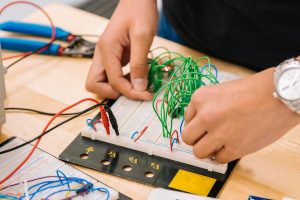The quiet art of a perfect solder joint
Soldering is an essential skill in the world of electronics and manufacturing. It involves joining two metal pieces together using a melted filler metal, known as solder. This process has been used for centuries, tracing back to ancient civilizations such as the Egyptians and Mesopotamians. However, in today’s fast-paced technological landscape, the art of soldering has evolved into a precise and quiet craft, practiced by skilled technicians and engineers. In this article, we will explore the quiet art of a perfect solder joint and the techniques used to achieve it.
Understanding Soldering and its Importance
Soldering is a technique used to permanently join two pieces of metal by using heat to melt a filler metal that flows into the joint and solidifies upon cooling. This process creates a strong and reliable bond that can withstand high temperatures, making it a preferred method for electronic connections.
In the world of electronics, a perfect solder joint is crucial for the proper functioning of electronic devices. It ensures that there is a secure connection between components, allowing for the efficient flow of electricity. A faulty solder joint can result in damaged electronic components, leading to failure of the device.
The Elements of a Perfect Solder Joint
Creating a perfect solder joint requires the right techniques, equipment, and materials. Here are the key elements that contribute to a flawless solder joint:
Cleanliness
Before starting the soldering process, it is vital to ensure that the metals being joined are clean and free of any impurities. Any dirt, grease, or corrosion on the surface of the metals can prevent the solder from properly adhering, resulting in a weak joint. It is recommended to clean the metal surfaces with a solvent or sandpaper before soldering.
Flux
Flux is a chemical substance used to clean the metal surface and protect it from oxidation during the soldering process. It helps the solder in flowing and adhering to the metal surface, creating a strong bond. There are various types of flux available in the market, and the choice depends on the type of metals being soldered.
Temperature and Heat Control
The temperature and heat control are crucial factors in soldering. The temperature of the soldering iron can significantly affect the quality of the joint. If the iron is not hot enough, the solder may not flow properly, resulting in a weak joint. On the other hand, if the iron is too hot, it can damage sensitive electronic components. It is essential to use a temperature-controlled soldering iron and monitor the temperature carefully.
The Solder
The composition and quality of the solder can greatly impact the final result. Generally, lead-tin alloy solders are used in electronic applications. However, due to health and environmental concerns, lead-free solders are becoming more popular. It is crucial to use high-quality solder to achieve a perfect joint. Lower-grade solders can result in weak or faulty solder joints.
The Technique
The technique used in soldering plays a significant role in creating a perfect joint. The three most common soldering techniques are through-hole soldering, surface mount soldering, and reflow soldering. Each technique has its benefits and requires different skills and equipment. It is essential to select the right technique for the specific application to achieve a flawless joint.
The Key to Achieving a Perfect Solder Joint – Practice
Soldering, like any other skill, requires practice to perfect. It takes time to develop the necessary skills and techniques, but with practice, you can achieve consistent and reliable results. It is essential to follow proper safety measures while practicing soldering to avoid any accidents.
In Conclusion
Soldering may seem like a simple process, but it requires precision, patience, and practice to achieve a perfect joint. The right combination of cleanliness, flux, temperature and heat control, high-quality solder, and proper technique is the key to creating a strong and reliable solder joint. With the continuous evolution of electronic devices, the art of soldering will continue to evolve, and it is crucial to stay updated with the latest techniques and tools to achieve the perfect joint every time.









